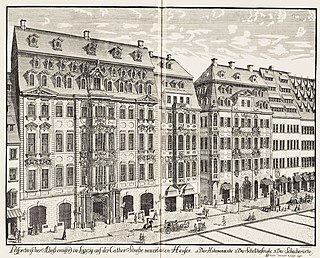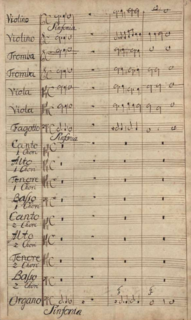Related Research Articles
The trio sonata is a genre, typically consisting of several movements, with two melody instruments and continuo. Originating in the early 17th century, the trio sonata was a favorite chamber ensemble combination in the Baroque era.
The Bach-Werke-Verzeichnis is a catalogue of compositions by Johann Sebastian Bach. It was first published in 1950, edited by Wolfgang Schmieder. The catalogue's second edition appeared in 1990. An abbreviated version of that second edition, known as BWV2a, was published in 1998.

Was mir behagt, ist nur die muntre Jagd, BWV 208.1, BWV 208, also known as the Hunting Cantata, is a secular cantata composed by Johann Sebastian Bach for the 31st birthday of Duke Christian of Saxe-Weissenfels on 23 February 1713. A performance lasts about forty minutes. The aria "Schafe können sicher weiden" is the most familiar part of this cantata.

Johann Ernst of Saxe-Weimar was a German prince, son by his second marriage of Johann Ernst III, Duke of Saxe-Weimar. Despite his early death he is remembered as a collector and commissioner of music and as a composer, some of whose concertos were arranged for harpsichord or organ by Johann Sebastian Bach, who was court organist in Weimar at the time.

Uns ist ein Kind geboren, BWV 142 / Anh. II 23, is a Christmas cantata by an unknown composer. In the Bach-Werke-Verzeichnis it is listed among the works with a doubtful attribution to Johann Sebastian Bach. The text is based on a libretto by Erdmann Neumeister first published in 1711. Although attributed to Bach by the Bach-Gesellschaft when they first published it in the late nineteenth century, that attribution was questioned within thirty years and is no longer accepted. Johann Kuhnau, Bach's predecessor as Thomaskantor in Leipzig, has been suggested as the probable composer, but without any certainty.
Most of Johann Sebastian Bach's extant church music in Latin —settings of the Mass ordinary and of the Magnificat canticle— dates from his Leipzig period (1723–50). Bach started to assimilate and expand compositions on a Latin text by other composers before his tenure as Thomaskantor in Leipzig, and he continued to do so after he had taken up that post. The text of some of these examples by other composers was a mixture of German and Latin: also Bach contributed a few works employing both languages in the same composition, for example his early Kyrie "Christe, du Lamm Gottes".

The concerto for two harpsichords in C minor, BWV 1060, is a concerto for two harpsichords and string orchestra by Johann Sebastian Bach. It is likely to have originated in the second half of the 1730s as an arrangement of an earlier concerto, also in C minor, for oboe and violin. That conjectural original version of the concerto, which may have been composed in Bach's Köthen years (1717–1723), is lost, but has been reconstructed in several versions known as BWV 1060R.

The Sonata in G major for two flutes and basso continuo, BWV 1039, is a trio sonata by Johann Sebastian Bach. It is a version, for a different instrumentation, of the Gamba Sonata, BWV 1027. The first, second and fourth movement of these sonatas also exist as a trio sonata for organ.

BWV Anh., abbreviation of Bach-Werke-Verzeichnis Anhang, is a list of lost, doubtful, and spurious compositions by, or once attributed to, Johann Sebastian Bach.

The Kyrie–Gloria Mass for double choir, BWV Anh. 167, is a mass composition in G major by an unknown composer. The work was likely composed in the last quarter of the 17th century. The composition has two sections, a Kyrie and a Gloria, each subdivided in three movements. It has twenty-two parts for performers: twelve parts for singers, and ten for instrumentalists, including strings, wind instruments and organ. Johann Sebastian Bach may have encountered the work around 1710, when he was employed in Weimar. In the 1730s he produced a manuscript copy of the Mass.

The organ sonatas, BWV 525–530 by Johann Sebastian Bach are a collection of six sonatas in trio sonata form. Each of the sonatas has three movements, with three independent parts in the two manuals and obbligato pedal. The collection was put together in Leipzig in the late 1720s and contained reworkings of prior compositions by Bach from earlier cantatas, organ works and chamber music as well as some newly composed movements. The sixth sonata, BWV 530, is the only one for which all three movements were specially composed for the collection. When played on an organ, the second manual part is often played an octave lower on the keyboard with appropriate registration. Commentators have suggested that the collection might partly have been intended for private study to perfect organ technique, some pointing out that its compass allows it to be played on a pedal clavichord. The collection of sonatas is generally regarded as one of Bach's masterpieces for organ. The sonatas are also considered to be amongst his most difficult compositions for the instrument.
The Triple Concerto, BWV 1044, is a concerto in A minor for traverso, violin, harpsichord, and string orchestra by Johann Sebastian Bach. He based the composition on his Prelude and Fugue BWV 894 for harpsichord and on the middle movement of his Organ Sonata BWV 527, or on earlier lost models for these compositions.
Johann Sebastian Bach wrote his fifth Brandenburg Concerto, BWV 1050.2, for harpsichord, flute and violin as soloists, and an orchestral accompaniment consisting of strings and continuo. An early version of the concerto, BWV 1050.1, originated in the late 1710s. On 24 March 1721 Bach dedicated the final form of the concerto to Margrave Christian Ludwig of Brandenburg.

Pietro Torri's Magnificat in C major for double choir and orchestra likely dates from the 1690s. The work is scored for two SATB choirs, two trumpets, bassoon, strings and basso continuo. Its music opens with an instrumental introduction (sinfonia). Most of the composition's movements are either choral movements, in which all singers and instruments participate, or duets for two singers and a more limited instrumental accompaniment.

The Magnificat in A minor, BWV Anh. 21, TWV 1:1748, is Melchior Hoffmann's musical setting of a German version of the Song of Mary from the Gospel of Luke. The composition originated around 1707, when the composer was director musices and organist of the Neue Kirche in Leipzig. Composed in A minor, the Magnificat is scored for soprano and small orchestra. The work was first published in the 1950s, and it was recorded by Magda László, by Joshua Rifkin, by Wolfgang Helbich, and by Deborah York, among others.